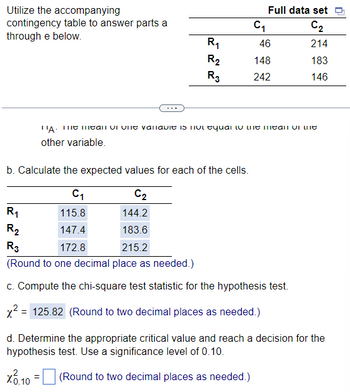answer parts a through e below. R₁ R₂ R3 C₁ b. Calculate the expected values for each of the cells. 46 148 242 HA: The mean of one variable is equal to the mean of the other variable. C. Ho: The two variables are independent. HA: The two variables are not independent. O D. Ho: The mean of one variable is equal to the mean of the other variable. HA: The mean of one variable is not equal to the mean of the other variable. C₂ 214 183 146
answer parts a through e below. R₁ R₂ R3 C₁ b. Calculate the expected values for each of the cells. 46 148 242 HA: The mean of one variable is equal to the mean of the other variable. C. Ho: The two variables are independent. HA: The two variables are not independent. O D. Ho: The mean of one variable is equal to the mean of the other variable. HA: The mean of one variable is not equal to the mean of the other variable. C₂ 214 183 146
Glencoe Algebra 1, Student Edition, 9780079039897, 0079039898, 2018
18th Edition
ISBN:9780079039897
Author:Carter
Publisher:Carter
Chapter10: Statistics
Section10.5: Comparing Sets Of Data
Problem 14PPS
Related questions
Question
100%
What is the chi-square test stat for the following problem?

Transcribed Image Text:Utilize the accompanying contingency table to
answer parts a through e below.
R₁
R₂
R3
C₁
Full data set
C₂
214
183
146
b. Calculate the expected values for each of the cells.
C₁
C₂
R₁
115.8
144.2
R₂
147.4
183.6
R3
172.8
215.2
(Round to one decimal place as needed.)
c. Compute the chi-square test statistic for the hypothesis test.
x² = (Round to two decimal places as needed.)
46
148
242
HA: The mean of one variable is equal to the mean of the other variable.
C. Ho: The two variables are independent.
HA: The two variables are not independent.
D. Ho: The mean of one variable is equal to the mean of the other variable.
HA: The mean of one variable is not equal to the mean of the other variable.
Expert Solution
This question has been solved!
Explore an expertly crafted, step-by-step solution for a thorough understanding of key concepts.
Step by step
Solved in 4 steps with 4 images

Follow-up Questions
Read through expert solutions to related follow-up questions below.
Follow-up Question
What is the appropriate critical value for the following?

Transcribed Image Text:Utilize the accompanying
contingency table to answer parts a
through e below.
R₁1
R₂
R3
x²0.10
R₁
R₂
R3
=
C₁
Full data set
C₂
214
183
146
b. Calculate the expected values for each of the cells.
C₁
C₂
115.8
144.2
147.4
183.6
172.8
215.2
(Round to one decimal place as needed.)
c. Compute the chi-square test statistic for the hypothesis test.
x² = 125.82 (Round to two decimal places as needed.)
d. Determine the appropriate critical value and reach a decision for the
hypothesis test. Use a significance level of 0.10.
(Round to two decimal places as needed.)
46
148
242
MA. me mean vivit valable is not equal to the mean on the
other variable.
Solution
Recommended textbooks for you

Glencoe Algebra 1, Student Edition, 9780079039897…
Algebra
ISBN:
9780079039897
Author:
Carter
Publisher:
McGraw Hill

Calculus For The Life Sciences
Calculus
ISBN:
9780321964038
Author:
GREENWELL, Raymond N., RITCHEY, Nathan P., Lial, Margaret L.
Publisher:
Pearson Addison Wesley,

Glencoe Algebra 1, Student Edition, 9780079039897…
Algebra
ISBN:
9780079039897
Author:
Carter
Publisher:
McGraw Hill

Calculus For The Life Sciences
Calculus
ISBN:
9780321964038
Author:
GREENWELL, Raymond N., RITCHEY, Nathan P., Lial, Margaret L.
Publisher:
Pearson Addison Wesley,